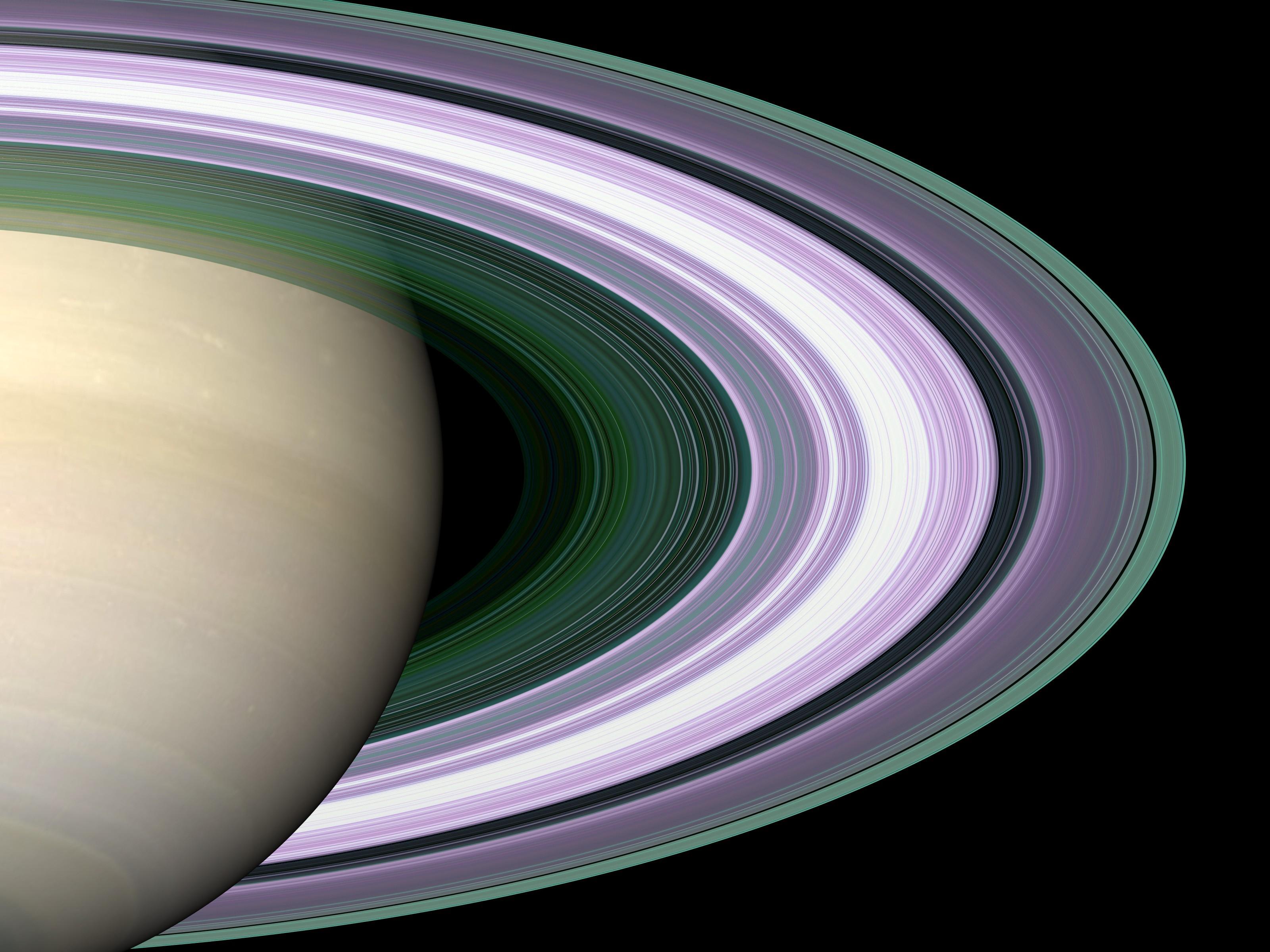

A simulated image of Saturn, constructed using Cassini images colorized to show various optical depths versus ring particle sizes. NASA/JPL-Caltech
Seismic waves in Saturn’s rings reveal the strange ‘fuzzy core’ interior of the planet within.
NASA’s Cassini spacecraft continues to uncover amazing facts about the ringed planet Saturn. A recent study in the August edition of Nature: Astronomy highlighted an intriguing method to indirectly probe the interior of the planet.
Typically, missions to the gas giant planets Jupiter and Saturn rely on direct measurements of gravity fields during flybys and orbits to characterize planetary interiors. This method, however, has a chief drawback, as it doesn’t describe whether the planet has a small, solid rocky or large liquid core.
For the recent study, astronomers took a different approach. Specifically, the Cassini mission looked at stellar occultations of distant stars passing behind the rings of Saturn. These observations were carried out in the final days of the mission known as the risky Grand Finale ring plane-crossing phase, done before the final destructive disposal of the spacecraft in the atmosphere of Saturn on September 15th, 2017.


During the occultations, Cassini observed very low frequency spiral waves traversing the inner C ring. The ring system itself is complex: thought to be part of a shredded moon, the major moons of Saturn pull and braid the outer ring system, while tiny shepherd moons are seen carving out paths in the rings, like the groves in a record. But it’s the planet itself that tugs on the inner sections such as the C-ring.
Astronomers soon realized that it was the surface of Saturn itself that was quivering to the tune of a meter every few hours, exerting tidal forces rippling through the ring system.
A Fuzzy Core
And what’s more, this oscillation says something about what’s going on inside Saturn itself. The best fit model suggests that rather than having a rocky distinct core, Saturn has a ‘fuzzy’ indistinct core extending about 60% of the way to the planet’s surface. Computer models suggest that the core is 55 times as massive as the Earth (Saturn iteself is 95 times as massive as Earth), with rock and ice only making up 17 Earth masses worth.
To stabilize a sloshing liquid core, astronomers realized that it had to be gradually mixed with heavier material, like layers in a cake. The Earth’s oceans produce a similar stabilized scenario, as salinity increases with depth.
“The fuzzy cores are like a sludge,” says Christopher Mankovich, a Caltech research associate in planetary science in a recent press release. “The hydrogen and helium gas in the planet gradually mix with more and more ice and rock as you move toward the planet’s center.”
Standard gravitational measurements made by Cassini also back up the ‘fuzzy/sloshy core’ model for Saturn. Many of us remember the mantra we were all taught as school kids, that Saturn has a low enough density to float in water… if you could somehow construct a pool for it that would not collapse into a planet in its own right.
Here another strange and (fun) fact that Cassini sought to solve before its destructive demise in 2017: we don’t actually know the exact rotational period of Saturn to as high a degree of precision as you might think. Like Jupiter and the Sun itself, Saturn is mainly a ball of spinning gas rather than a single solid object: confounding this is the fact that visual observations and radio measurements made by spacecraft do not precisely match up. The current radiometric value for the rotational period of Saturn stands at 10 hours and 39 minutes.
Studies of Saturn’s magnetic field structure could also support or refute the blurred core hypothesis; in the fuzzy core model, for example, a stable layered core wouldn’t also be churning and creating a vast planet wide magnetic field; instead, the magnetic field of Saturn would be generated in the exterior gaseous envelope.
This finding also has implications for revising how we think about the complex interiors of gas giant planets, both in our solar system and in exoplanets beyond. NASA’s Juno mission is also grappling with probing the interior of Jupiter in detail.
Unfortunately, it’ll be a while before we go back to Saturn: the next mission in the pipeline isn’t until 2027, when the nuclear-powered Dragonfly helicopter heads to Saturn’s large moon Titan.
You can see Saturn for yourself and ponder all of these amazing facts – The ring’d world is fresh off of opposition on August 2nd, and rules the dusk sky low to the east at sunset in late August along with Jupiter.
What other mysteries await humanity at this most photogenic of worlds?
-Lead image: A simulated image of Saturn, constructed using Cassini images colorized to show various optical depths versus ring particle sizes. NASA/JPL-Caltech
This Hubble image shows a supernova named SN 2022aajn in a distant galaxy about 600…
It seems everyone is talking about the Moon and everyone wants to get their foot…
We can't help ourselves but wonder about life elsewhere in the Universe. Any hint of…
When a star like the Sun dies, it puffs away its outer layers, leaving behind…
In the more than sixty years where scientists have engaged in the Search for Extraterrestrial…
Sailing has been a mainstay of human history for millennia, so it's no surprise that…